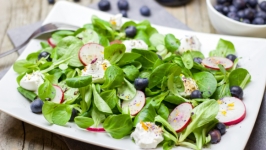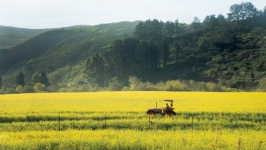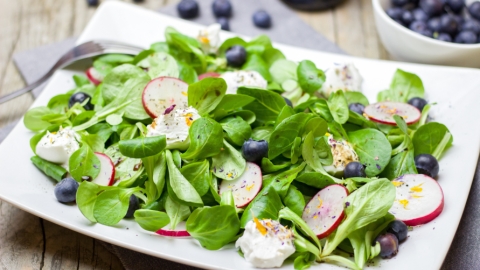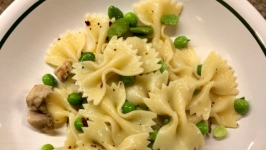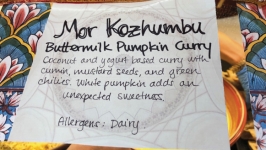Farm-Fresh Servings
Local restaurants showcasing ingredients and seasonal menu items sourced fresh from the farm.
“The reason they make pots that you cook with on the stove round is so you can always change direction when you’re cooking,” Chef Greg Kuzia-Carmel at Menlo Park’s Camper heard from a station mate while cooking in Spain. The idea typifies the way some Bay Area chefs are designing their menus—changing direction based upon seasonal rhythms of local farms.
And it’s not just that chefs are incorporating ingredients from area farms—many of those farms are being called out by name on quickly evolving menus. Names and places like Bellwether Farms, Cypress Grove cheeses and Glaum Egg Ranch are printed on menus. Porta Blu, Meso and Camper are three of these seasonally focused restaurants that showcase their devotion to locally sourced ingredients on their ever-changing menus.
While other parts of the country deal with ice and snow or searing heat, much of the California coastline, Santa Cruz Mountains and Salinas Valley don’t face such obstacles. “There’s just this amazing vitality from local farms that exists 12 months out of the year,” says Camper’s Chef Kuzia-Carmel. The restaurant’s relaxed vibe and rustic design of exposed beams, landscape pictures and outdoor curios is inspired by Mother Nature, and so is what’s on the menu. Culinary spontaneity dictated by what’s in season results in creations like an earthy charred eggplant dip and fresh homemade rigatoni.
![]() Going “farm to menu” and focusing on gathering ingredients from local farms harks back to the dawn of humanity. It used to be the only option people had before the industrialization of food processing, storage and transportation. Ingredients from far away initially had an exotic appeal, but the once-exotic has become commonplace. Diners are accustomed to and may expect access to any kind of food year-round.
Going “farm to menu” and focusing on gathering ingredients from local farms harks back to the dawn of humanity. It used to be the only option people had before the industrialization of food processing, storage and transportation. Ingredients from far away initially had an exotic appeal, but the once-exotic has become commonplace. Diners are accustomed to and may expect access to any kind of food year-round.
The return to farm-to-table mindset started in the U.S. in part with Berkeley’s Chez Panisse in 1971. The movement has continued to grow and spread throughout California, the country and the world. That continued focus on featuring the work of local farms has helped build the prominence of Bay Area restaurants. Menlo Park’s Porta Blu is all about coastal California flavors infused with worldwide influences, serving up dishes like chilled octopus and Niman Ranch lamb dip. “Much of the Peninsula and Silicon Valley has become a dining destination simply because of the way restaurants like us choose to showcase local ingredients,” explains Porta Blu’s Chef Marck Banagan.
Cooking with Seasonality in Mind
It’s easier for chefs when they’re planning menus to use the same set of ingredients year-round. When using seasonally available ingredients, change is inevitable and that can be challenging. Meso, a new Santana Row restaurant in San Jose, serves modern Mediterranean dishes designed to bring people together—small plates to share or one dish for the entire table to dig into like their crispy and juicy full roasted Mary’s Free Range Chicken. Chef Gregory Short embraces and celebrates change as part of the job, “I’m a very seasonal chef. If it’s not available locally, I don’t use it.” Local farms and what they are growing add eloquence to Chef Short’s menus. “I want whatever the farmers and growers are producing nearby. I’m not going to pull something from out of the region just to have it on the menu.”
Being able to use high-quality local ingredients is a benefit for all involved, spurring an ongoing relationship between the restaurant and the farmers and ranchers. “Our relationships with Point Reyes Farmstead Cheese Co., Glaum Egg Ranch and Pitman Family Farms ensure that our menus uphold the standard our guests expect to receive when dining,” says Chef Banagan. “We want to use the best products and pay homage to the farmers for the time and work they put into their craft.”
![]() Because of the close relationships these restaurants have cultivated with farmers, they sometimes get a say into what’s planted. For instance, Camper Chef Kuzia-Carmel asked a local pepper farmer to grow a rare pepper for the restaurant. “If it succeeds, we’ll be one of the few restaurants on the West Coast with the vaunted ají dulce pepper.”
Because of the close relationships these restaurants have cultivated with farmers, they sometimes get a say into what’s planted. For instance, Camper Chef Kuzia-Carmel asked a local pepper farmer to grow a rare pepper for the restaurant. “If it succeeds, we’ll be one of the few restaurants on the West Coast with the vaunted ají dulce pepper.”
The Daily Dish
With menus changing almost daily to feature in-season ingredients, the names of featured local farmers and ranchers are increasingly written on the menus, receiving well-earned exposure for their products. Chef Banagan says, “A lot of the guests aren’t familiar with the purveyors, so they’re becoming more educated. They’re learning to recognize the name and know the quality.” The other chefs are in agreement. Chef Short says, “It’s great advertisement for local farmers to be on the menu and highlight their products through a local restaurant.”
By focusing on fresh, local ingredients, you’re likely to get flavor profiles and quality that you literally wouldn’t be able to get anywhere else. Putting a place to the name of an ingredient like lettuce from Pescadero gives you a chance to think about and imagine just who it is and how it is this lettuce made its way to your plate. As diners get to enjoy a literal taste of the area, it becomes a unique dining experience and a chance to feel connected to where you are.
Peak Season
![]() Oftentimes, imported ingredients may be cheaper, but with the potentially higher price of going local, you get consistent quality from trusted sources. There’s also an overall environmental benefit; enjoying food from local farms means taking a positive step towards greater sustainability. And perhaps most importantly, local ingredients taste fantastic.
Oftentimes, imported ingredients may be cheaper, but with the potentially higher price of going local, you get consistent quality from trusted sources. There’s also an overall environmental benefit; enjoying food from local farms means taking a positive step towards greater sustainability. And perhaps most importantly, local ingredients taste fantastic.
Part of what makes local dishes so delicious is the intense flavors of an ingredient at its absolute peak of ripeness and freshness. But that can be a double-edged sword. If you fall in love with something on one of these restaurants’ menus, it’s possible you may not be able to get it the next time you’re there. Chef Kuzia-Carmel details the dilemma: “You play the game of wanting to show people ingredients picked at their peak, but at the same token, people may expect that year-round.”
He’s not alone. “I anticipate that there will be something I take off that people will miss, but there will be an alternative,” says Chef Short. It’s really all about getting diners to realize the seasonal changes of production and helping ease us into the value of including only the best and tastiest local ingredients on a menu.
It can also be a stressful situation for the chef. By committing to using solely what’s in season at Camper, things for Chef Kuzia-Carmel can change minute to minute. “We get anywhere between 15 and 20 deliveries from farms and small vendors per week. If an ingredient is not available, we have to change course.”
That challenge for the chef, however, leads to new tasty options for guests. Ask your server where the ingredients are from for a chance to find out more about the farms, ranches and fishing sites around you. And if you don’t see your favorite on the menu anymore, breathe deep and try something new. You’ll be helping the planet, helping local farmers, and you might just find a new favorite.
